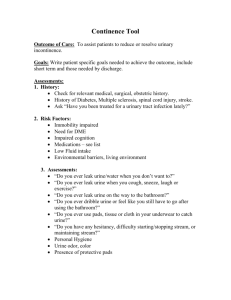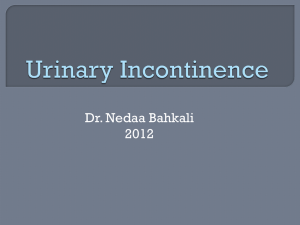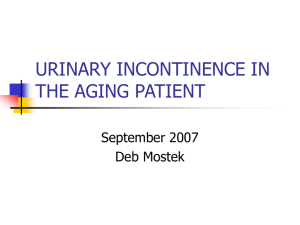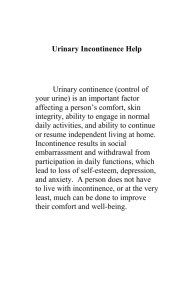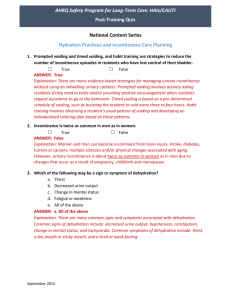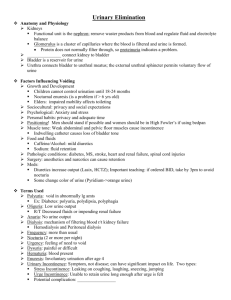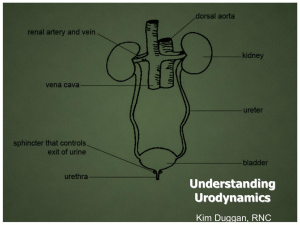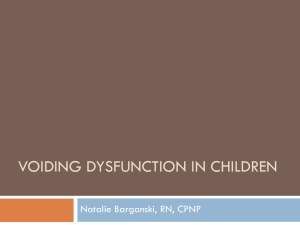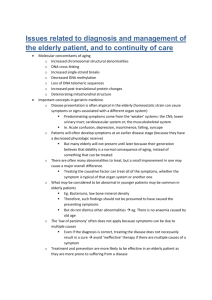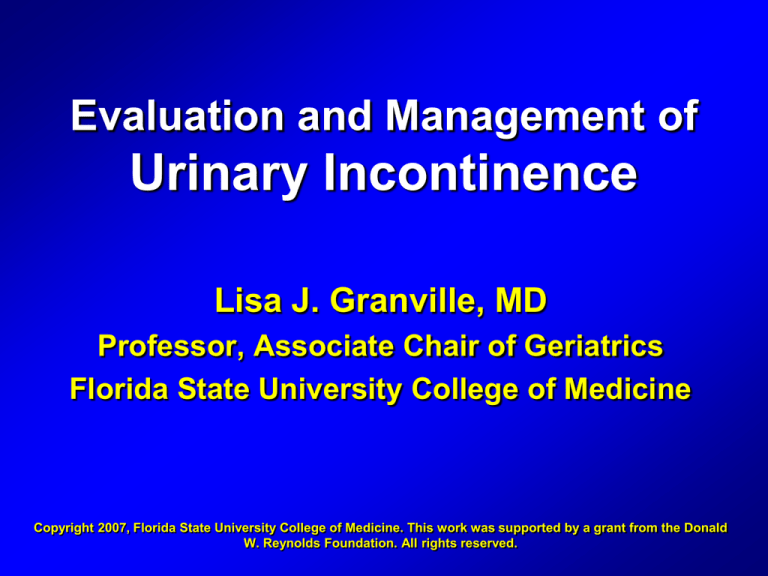
Evaluation and Management of
Urinary Incontinence
Lisa J. Granville, MD
Professor, Associate Chair of Geriatrics
Florida State University College of Medicine
Copyright 2007, Florida State University College of Medicine. This work was supported by a grant from the Donald
W. Reynolds Foundation. All rights reserved.
Definition of Incontinence:
The involuntary loss of
enough urine to cause
social or hygienic problems.
Reported prevalence rates
of UI vary depending on:
Population studied
Definition of UI
How the information is obtained
Case Scenario:
Mrs. Jones, a 76 year old woman, confides in
you that she has problems controlling her
urine. She reports that she stays close to
home and always knows where the
bathrooms are.
She has had intermittent UI. Urine loss is
precipitated by rushing, running water, and
hand washing. Sometimes she loses urine
when she coughs, sneezes or laughs. She
now wears pads daily.
She is concerned that the problem is more
frequent and interfering significantly with her
daily golf game.
Requirements for
Continence
•
•
•
•
•
Mentation
Motivation
Mobility
Manual Dexterity
Proper Lower Urinary Tract Function
Normal Changes
Which Predispose the Elderly to
Incontinence
DECREASED
• Bladder Capacity
• Inhibitory Ability
• Urethral Closing
Pressure
INCREASED
• Residual Volume
• Uninhibited
Detrusor
Contractions
Incontinence is not
a normal part of aging.
Decision Point 1:
What contributors are present?
• Transient (reversible)
• Established (chronic)
Transient Incontinence
(Normal Lower Urinary Tract)
•
•
•
•
D Drugs
R Restricted Mobility
I Infection
P Polyuria
•
•
•
•
D Dietary
R Retention of Feces
I Inflammation
P Psychological
Drugs/Dietary
Contributors to Incontinence
Decreased Storage
Increased Retention
•
•
•
•
•
•
•
•
•
Alpha blockers
Beta blockers
Cholinergic agents
Diuretics
– Caffeine
– ETOH
• Artificial sweeteners,
citrus, carbonation
Alpha agonists
Beta agonists
Anticholinergic agents
Ca channel blockers
Narcotics
What diagnostic tests would
you perform?
Per AHCPR Guideline:
• thorough history
• relevant physical examination
• voiding diary
• urinalysis
• post void residual
Voiding Diary: Purpose
•
•
•
•
Assess severity
Determine precipitating events
Identify fluid intake patterns
Identify voiding patterns
Mrs. Jones’ Voiding Diary
(Refer to Handout)
•
•
•
•
•
Voiding interval
Leakage episodes
Pad use
Food / fluids
Activity
Decision Point 2:
What type(s) of established UI?
• Functional
• Abnormal lower urinary tract
Lower Urinary Tract
Impairments of Function
Store
Release
Bladder
URGE
OVERFLOW
Urethra
STRESS
OBSTRUCTIVE
PVR
0-100
PVR
PVR
> 200
Urge Incontinence
aka: Detrusor Instability, Detrusor
Hyperactivity, Detrusor Overactivity
Most common etiology
Frequent voiding of moderate amounts
Problem occurs day and night
Normal PVR
Stress Incontinence
Leakage of small amounts of urine with
increased abdominal pressure
Dry at night
Normal PVR
Neurogenic Overflow
Incontinence
aka: Myopathic
Detrusor contractions weakened by
muscular or neurologic disease
Frequent loss of small to moderate
amounts
Occurs day and night
Increased PVR
Obstructive Overflow
Incontinence
Elimination incomplete from urethral
blockage
Primarily men with prostate disease
Frequent loss of small to moderate
amounts
Occurs day and night
Increased PVR
Back to Mrs. Jones…..
• What type of UI does she appear to
have?
Mr I.P. Alot is a 72 year old
man who complains of one
month history of progressive
difficulty initiating urination,
weak stream, incomplete
emptying, frequency, urgency,
and abdominal discomfort. He
leaks small amounts of urine
frequently.
Mr I.P. Alot has a history of
hypertension and benign
prostatic hypertrophy.
His medications include:
Metoprolol 25mg bid
Elavil 25mg qHS
Tylenol 650mg prn
67 year old man with a history
of hypertension, BPH, prostate
cancer s/p radical
prostatectomy reports small
volume urinary incontinence
interferes with his work as a
handy man.
Back to Mrs. Jones…..
• What type of UI does she appear to
have?
Answer: URGE
• What therapies would you
recommend?
Decision Point 3:
What type(s) of management?
Major Categories of UI Treatment
• Behavioral
• Pharmacological
• Surgical
Per AHCPR Guideline:
• Start with behavioral or pharmacological
approach
• Patient preference/ motivation must be
considered in treatment selection
Bladder Training
Requires the patient to resist or
inhibit the sensation of urgency,
postpone voiding, and urinate
according to a timetable
Pelvic Muscle Rehabilitation
• Pelvic muscle exercises – active
exercises to increase periurethral
muscle strength
• Biofeedback – use of electronic or
mechanical instruments to display
information about neuromuscular
and/or bladder activity
Pharmacologic Treatment :
URGE
• Anticholinergic agents (first line)
– Darifenacin
– Oxybutinin
– Solifenacin
– Tolterodine
– Trospium
Alternative Management &
Supportive Measures
•
•
•
•
•
•
•
Intermittent catheterization
Indwelling urethral catheterization
Suprapubic catheters
External collection systems
Penile compression devices
Pelvic organ support devices
Absorbent pads or garments
When would you consider
referral to a specialist?
• Uncertain diagnosis
• Failure to respond to an adequate
therapeutic trial
• Hematuria without infection
• Recurrent symptomatic UTIs
• Abnormal PVR
Where can you get help?
•
•
•
•
•
Urology
Gynecology
Geriatrics
Physical therapy
Clinical nurse specialist
Collaborative Management of UI
• Deliver large amounts of patient
education, repeat information over time
• Lead patient through a series of informed
decisions about diagnostic and
therapeutic options
• Provide self management skills
Professional tools, patient forms, patient
education handouts are available at:
gericareonline.net

